|
LabGuy's World: Marsan Pixicam Restoration, Part 2
[HOME] [ELECTRONICS PROJECTS] [PART 1] 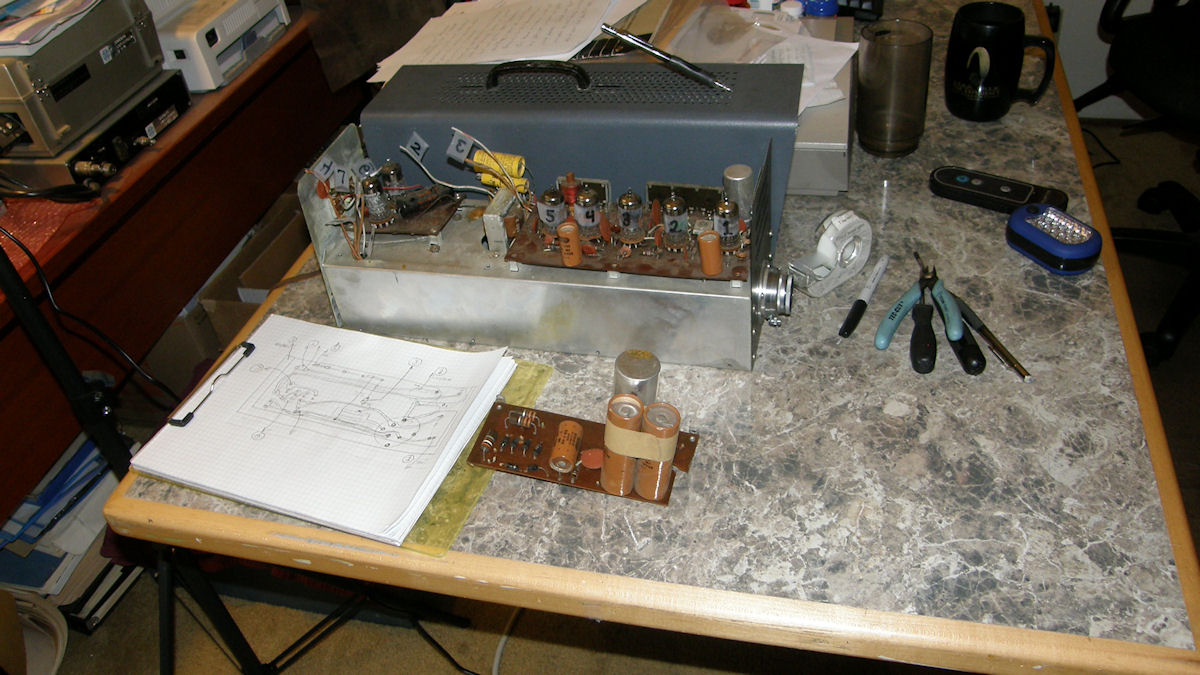
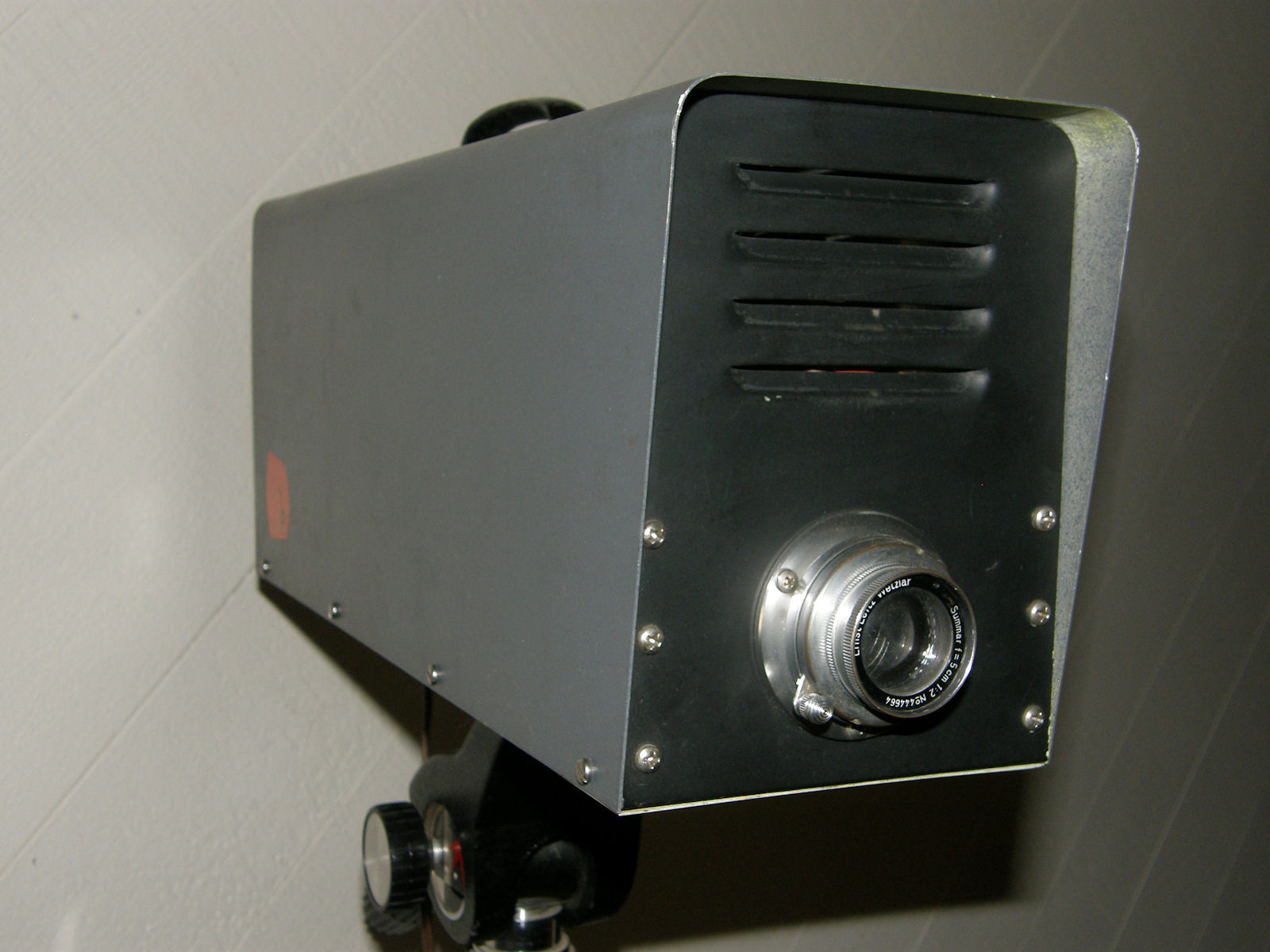
Let the Pixicam restoration begin! - 20160909 Here we see the Pixicam after the removal of the power supply board. As I do this task, I mark each wire with a tag made of tape and asign it a number. At the same time, I draw a pictorial diagram of the bottom side of the circuit board, noting where each wire is connected and where each component is placed. All of this in the preparation to replace all of the electrolytic capacitors before moving on. I've also prenumbered the five vacuum tubes on the main PCB. 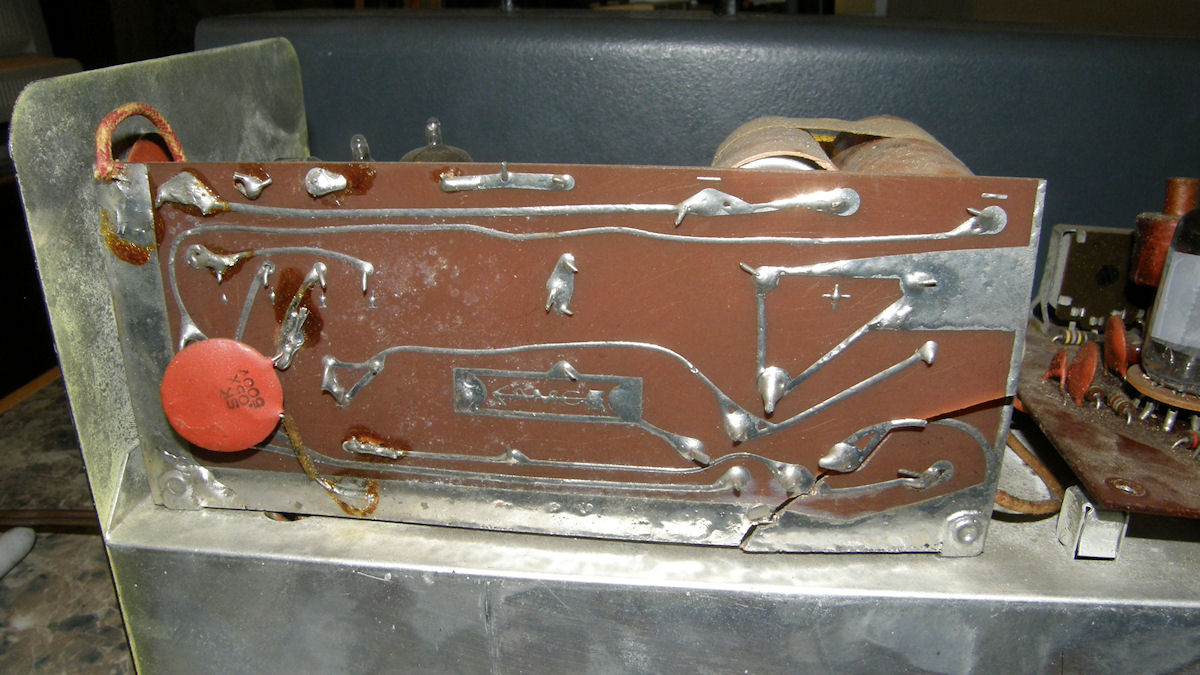
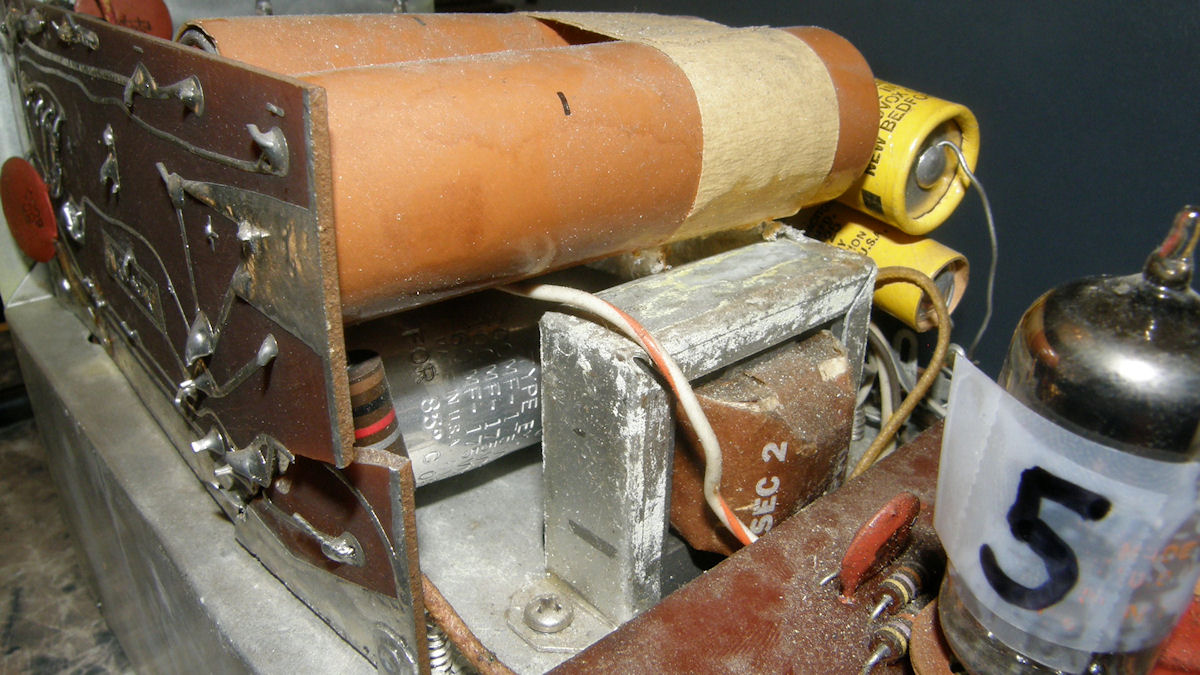
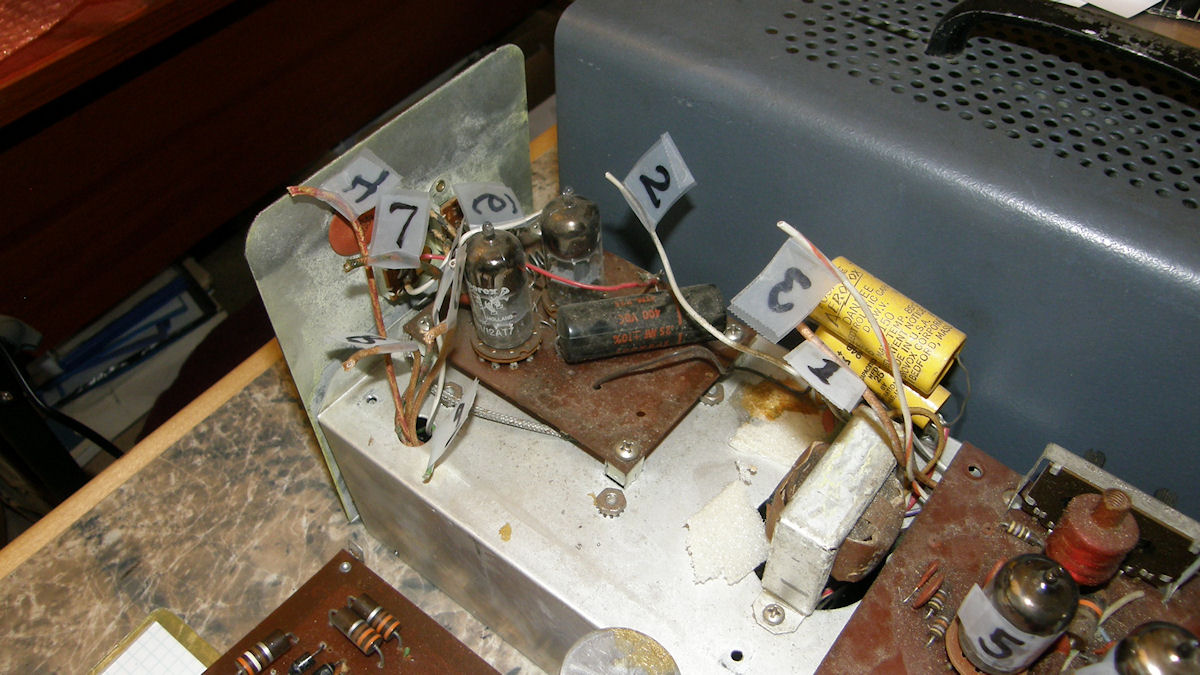
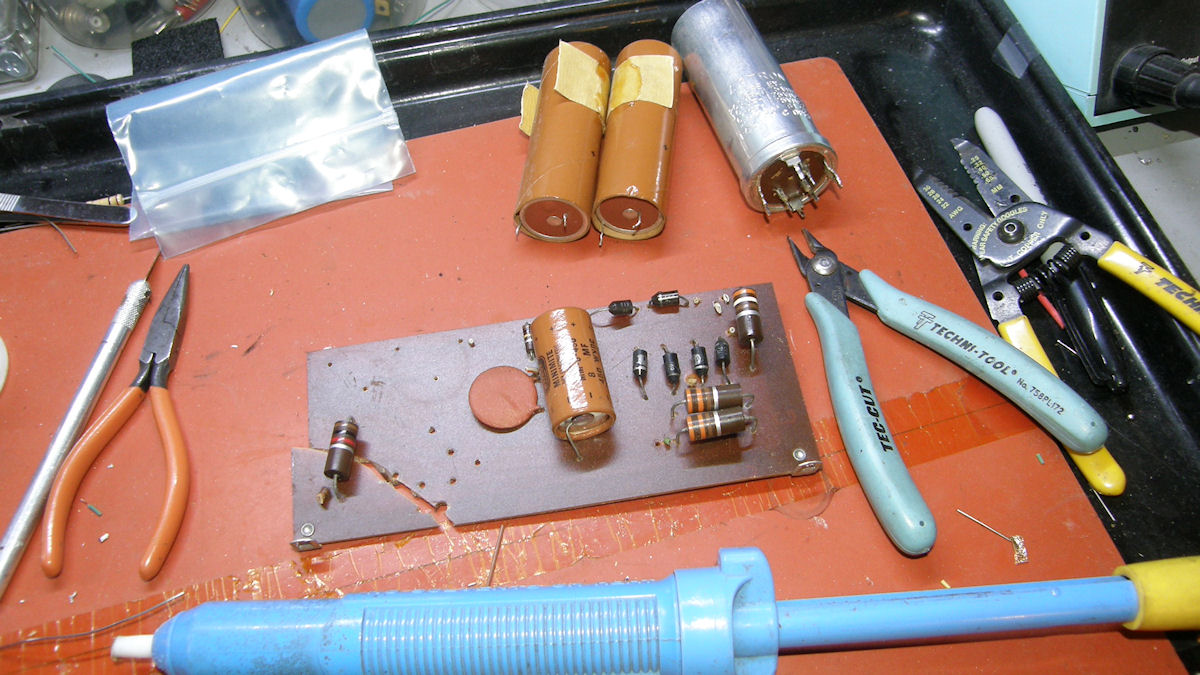
We will begin by repairing the DC power supply - 20160909 The first and last photos clearly show the minor shipping damage. This was caused by the rotting out of some foam rubber tape that supported the three very heavy filtering capacitors against the blocking oscillator transformer. As you can plainly see in photo #2, the foam tape is completely gone! Installed in 1960 and completely turned to dust today, in 2016, 46 years later. Yep! That's exactly what I would expect. I drew a diagram and labeled the wires, one by one, as I carefully disconnected them. I took the board to the bench and removed all of the electrolytic capacitors. New parts have been ordered and will be here on Monday. The multi-gang 3 section capacitor will be replaced by discrete units. The break in the PCB will be patched up at that time. 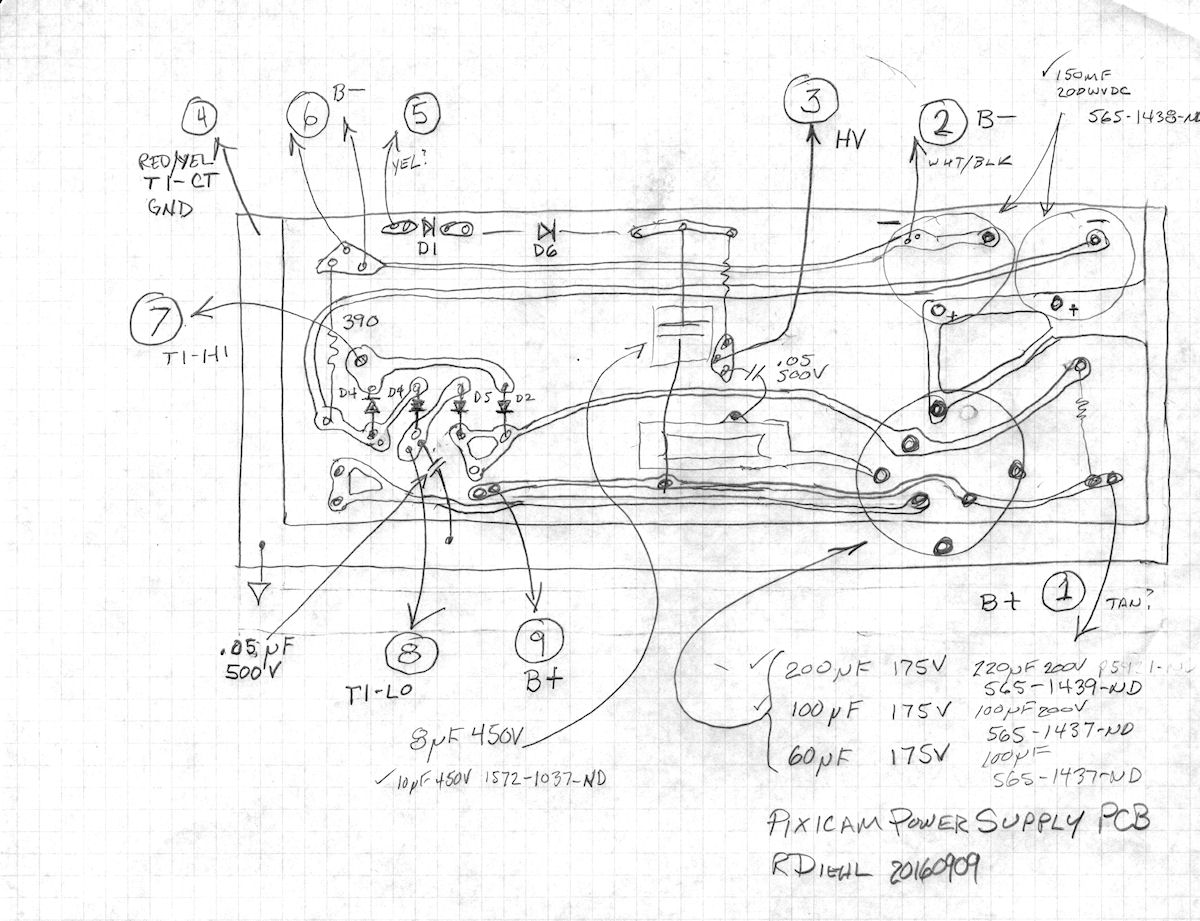
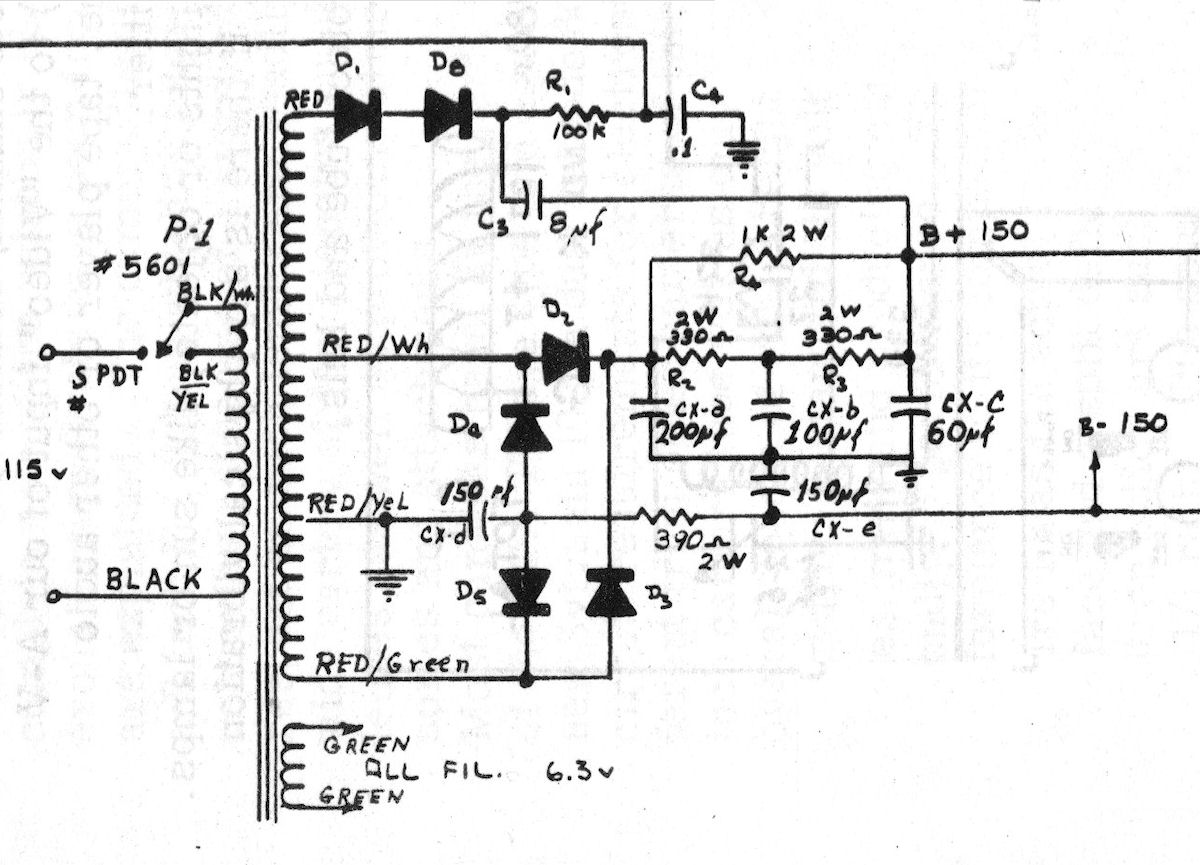

My pictorial diagram of the PCB, original schematic and my redrawn schematic - 20160909 The circled numbers on the pictorial diagram correspond to the tags on their matching disconnected wires. We are viewing the PCB from the back side. In 1960, the layout is either hand drawn with a laquer pen or laid out with special tape on acetate film. This pattern was photographically transfered to a light sensitive emulsion applied to the copper clad phenolic board. After developing, the PCB etched in the usual way. Phenolic baseboard is as cheap as it gets. Remember, Denson was going for absolute lowest cost possible. The way this circuit board broke demonstrates the greatest short coming of this material. It is just too brittle. If I decide to replace it, I will use a fiberglass board. The Pixicam power supply is not a very complicated circuit. But, the original diagram, as drawn, is unfriendly to read. My diagram follows the left to right flow rule and untangles the spaghetti. The wire numbers are indicated to help you see where these connected on the pictorial diagram. The vertical "stacking" of the DC output voltages is also in sequential order, most negative at the bottom, most positive at the top. I don't yet know the value of the HV voltage. I am guessing in the range of +300 to +450 volts. This voltage drives the Pixicon tube scan centering and astigmatism controls. With a 100K series resistor in this line, it certainly does not consume much power. The +/-150 volts is for the RF modulator, deflection and video amplifier tubes. (The pictorial diagram and my schematic were revised on 20160918) 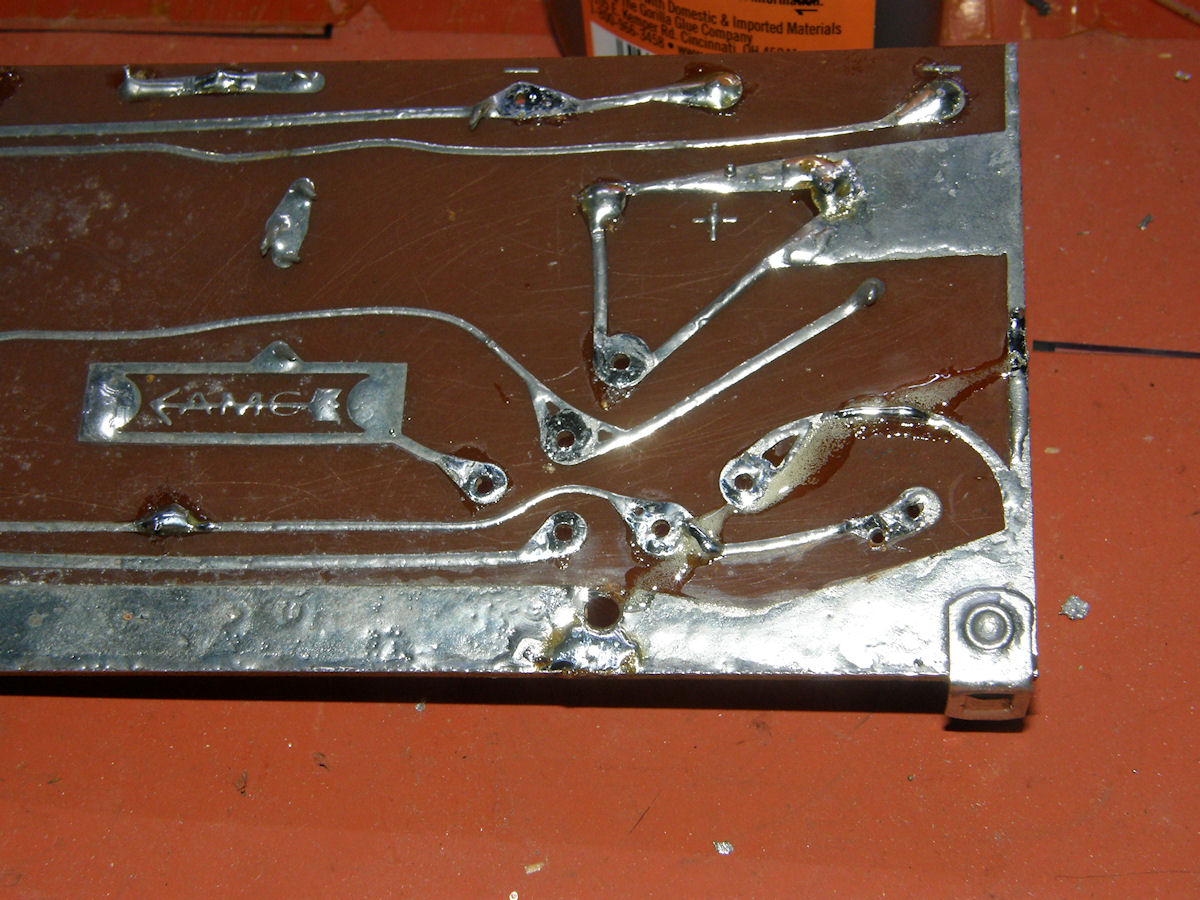
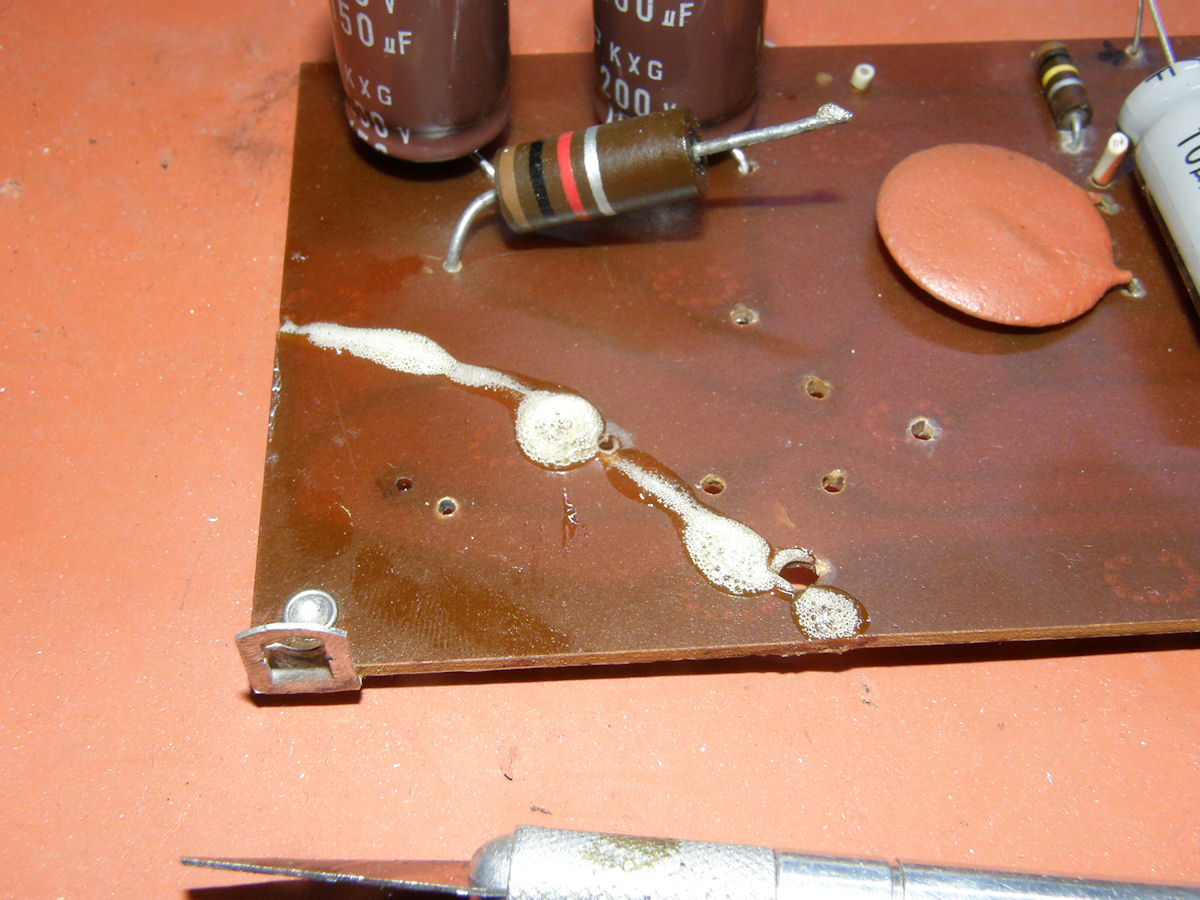
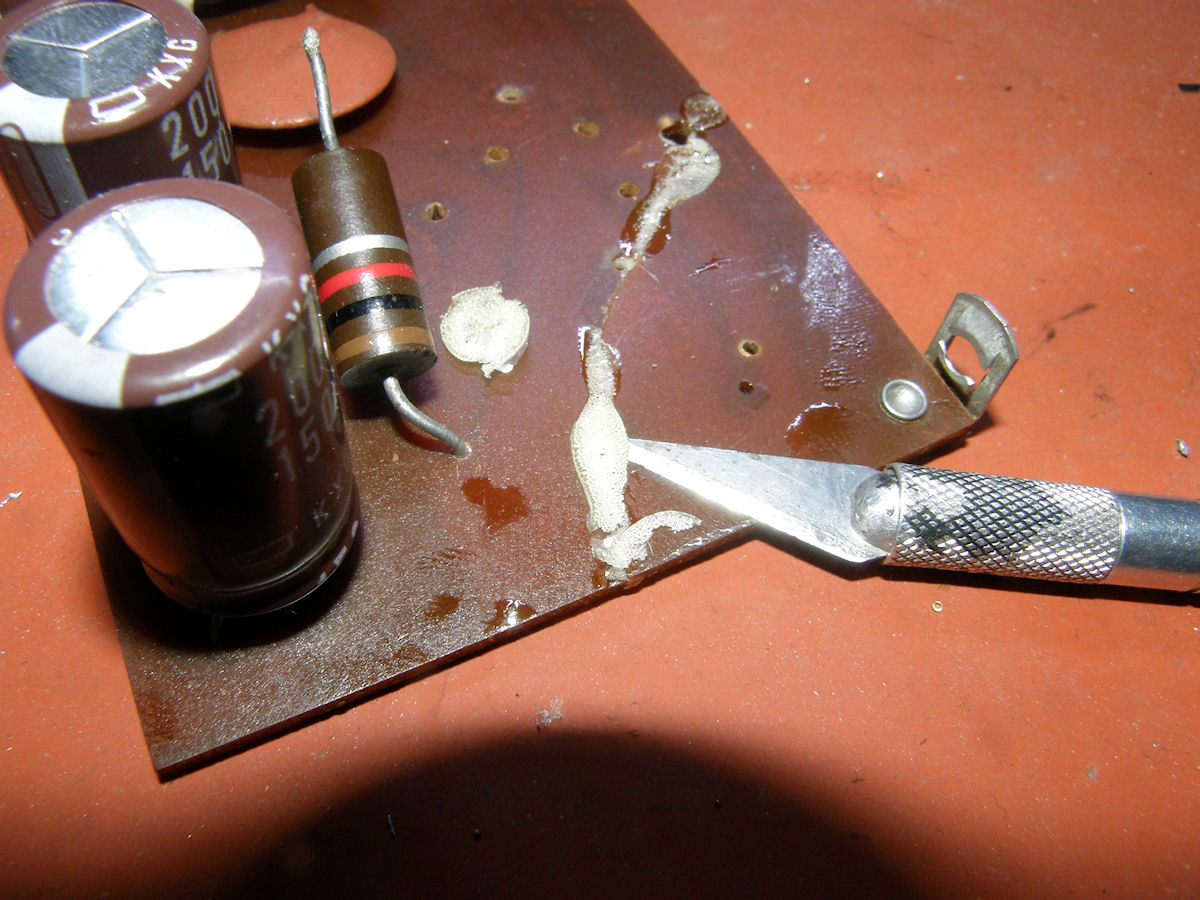
First we fix the broken corner of the PCB with Gorilla Glue(R) - 20160918 Using Gorilla Glue, I reattached the two piece of phenolic board and let it set for an entire week or more. This glue has a tendency to expand and foam up while curing. The result is unsightly, even if the bond appears to be stronger than the original phenolic material! This excess glue was scraped off easily with my hobby knife. A careful bending test proved to me that the bond was incredibly strong. This glue resembles a very high strength plastic when cured. Phenolic circuit board is made by impregnating a coarse fiber paper core material with an organic resin and then baking it in a high temperature flat press. This is very cheap to make. But, not very robsust. As mentioned previously, it is very brittle and prone to breaking as we have seen here. 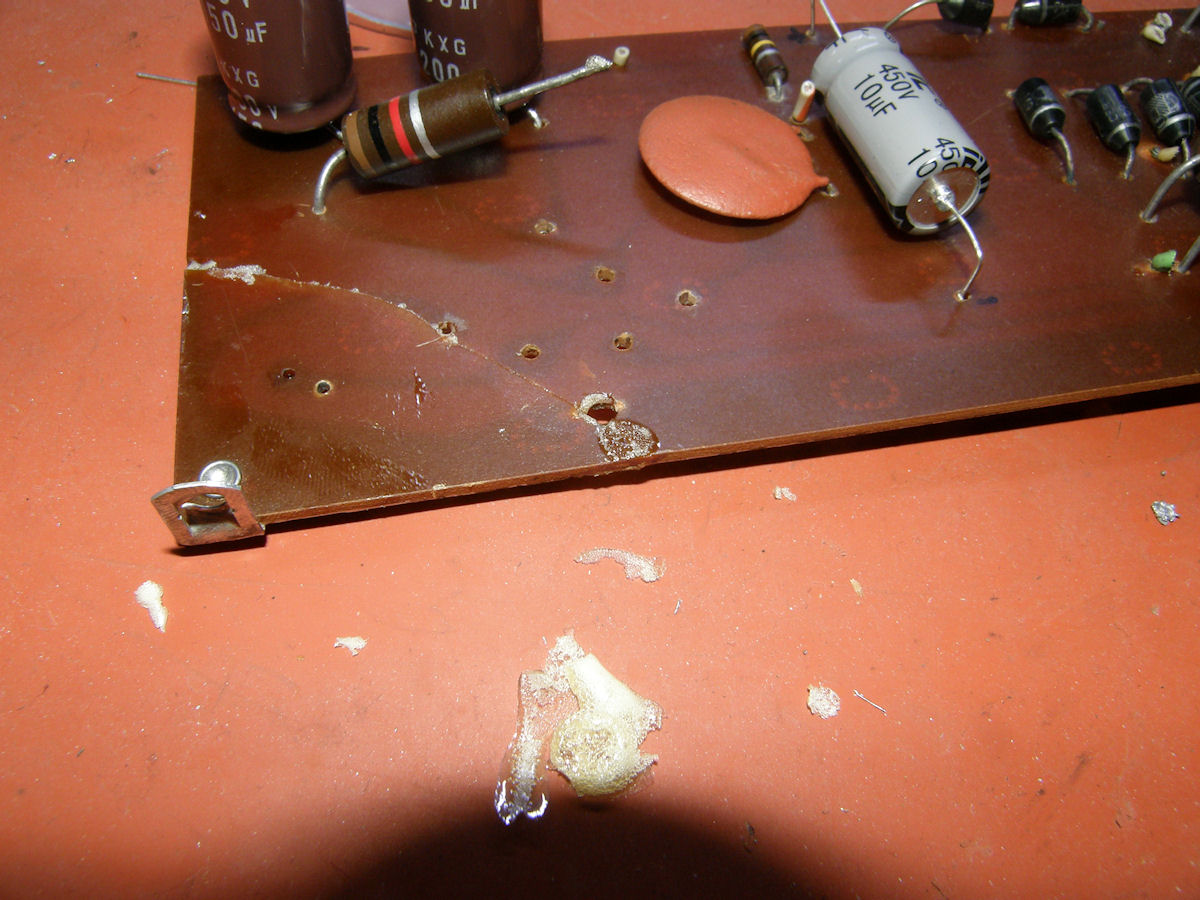
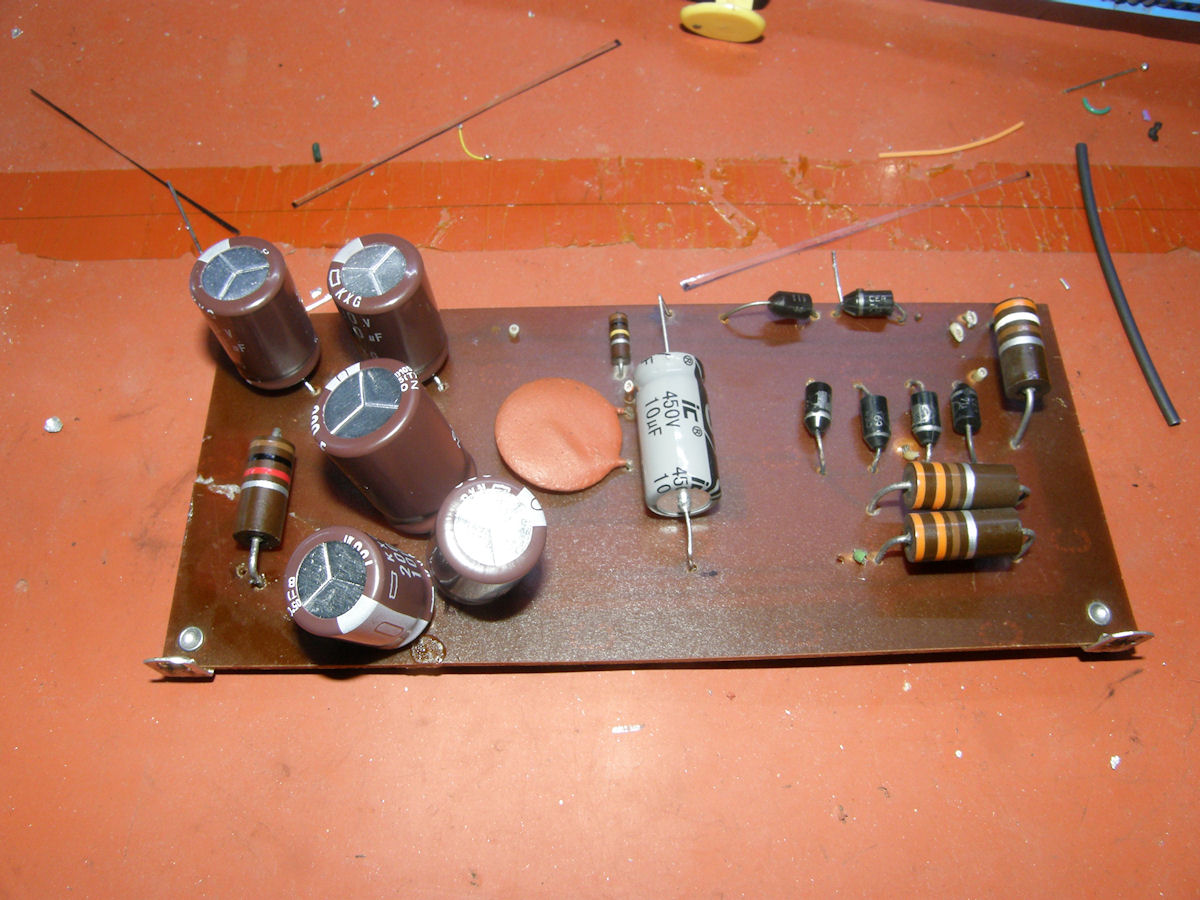
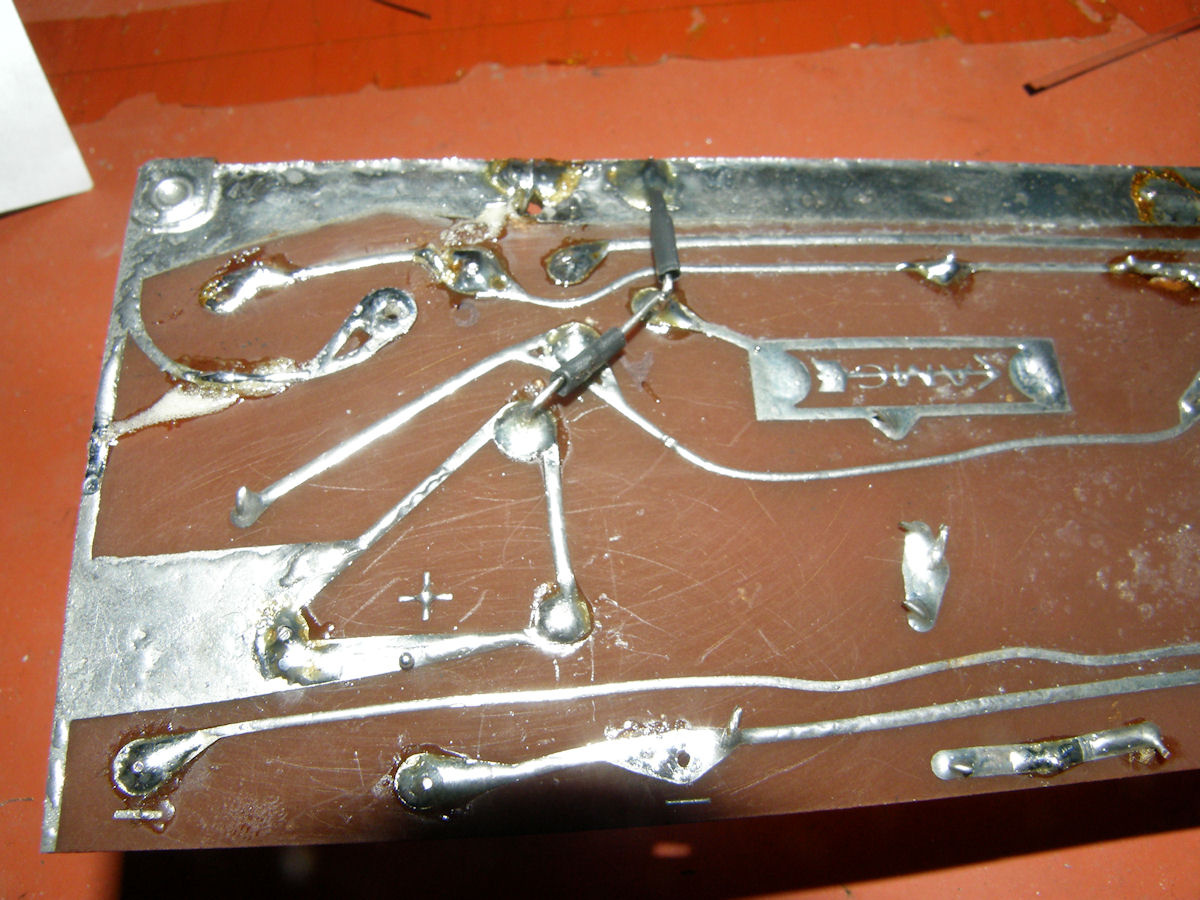
Installing brand new capacitors - 20160918 Spending less than twelve dollars at [Digi-Key], I was able to get replacement capacitors for this board. An excellent bargain! Another awesome source of replacement capacitors and other obsolete parts, especially vacuum tube power transformers, is [Antique Electronc Supply]. Exact value caps were not available. So, I used the nearest next highest value in most cases. For instance, the 8uF capacitor was replaced with a 10uF capacitor. The metal canned triple capacitor was replaced with three discrete capacitors. 220uF (200uF), 150uF (100uF) and 100uf (60uF) respectively. Since the original designer used the metal can of the triple capacitor to bridge some of his his ground traces together, I had to install some jumper wires to reestablish those circuits. The new capacitors are also about one third the mass of the original parts. So, the board should no longer experience so much mechanical stress. The results are not perfectly pretty. But, they are also not as ugly as it could be! The DC power supply board is now fully restored. 
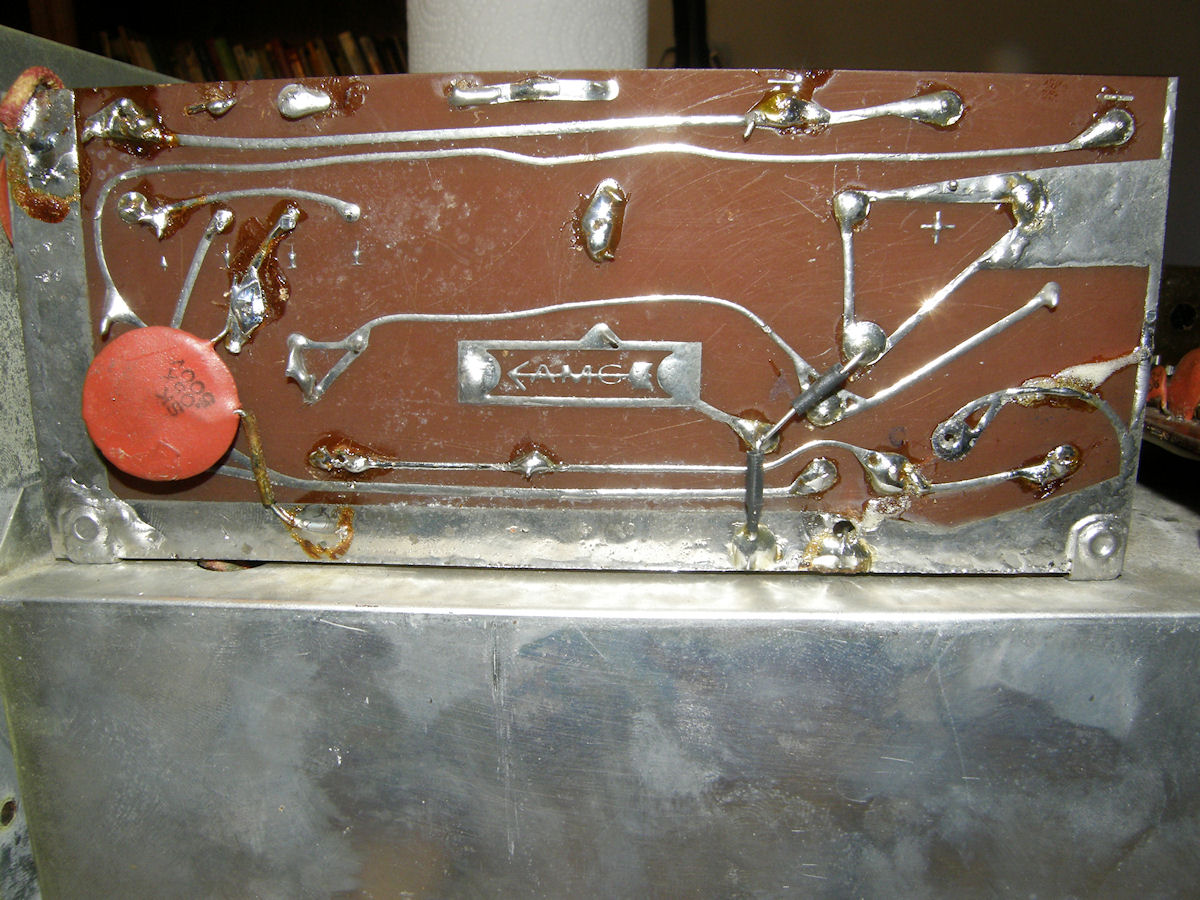
Before and after photos of the power supply board PCB - 20161001 I finally got a few minutes to work on the Pixicam today. As shown in the photos above, the power supply PCB is back in place and wired up. The repair is hardly visible. 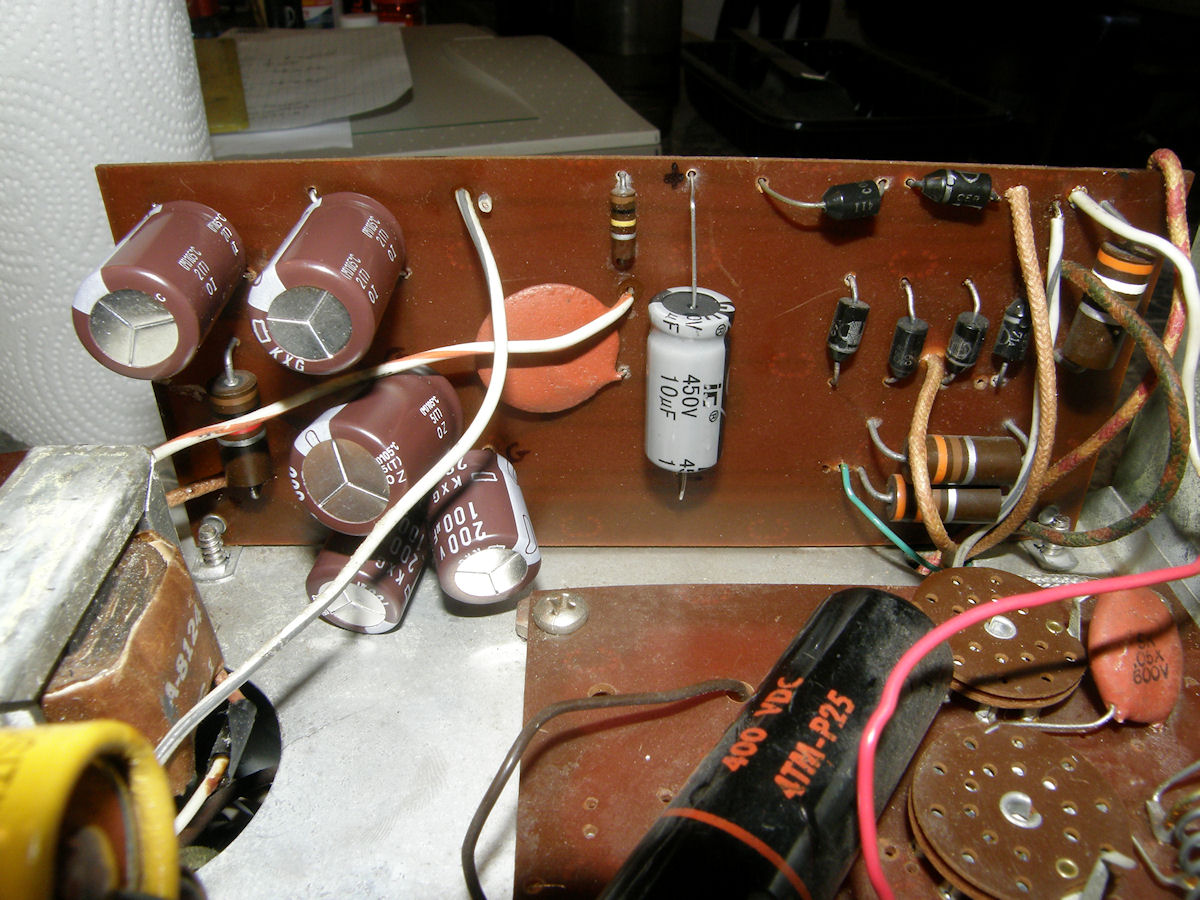
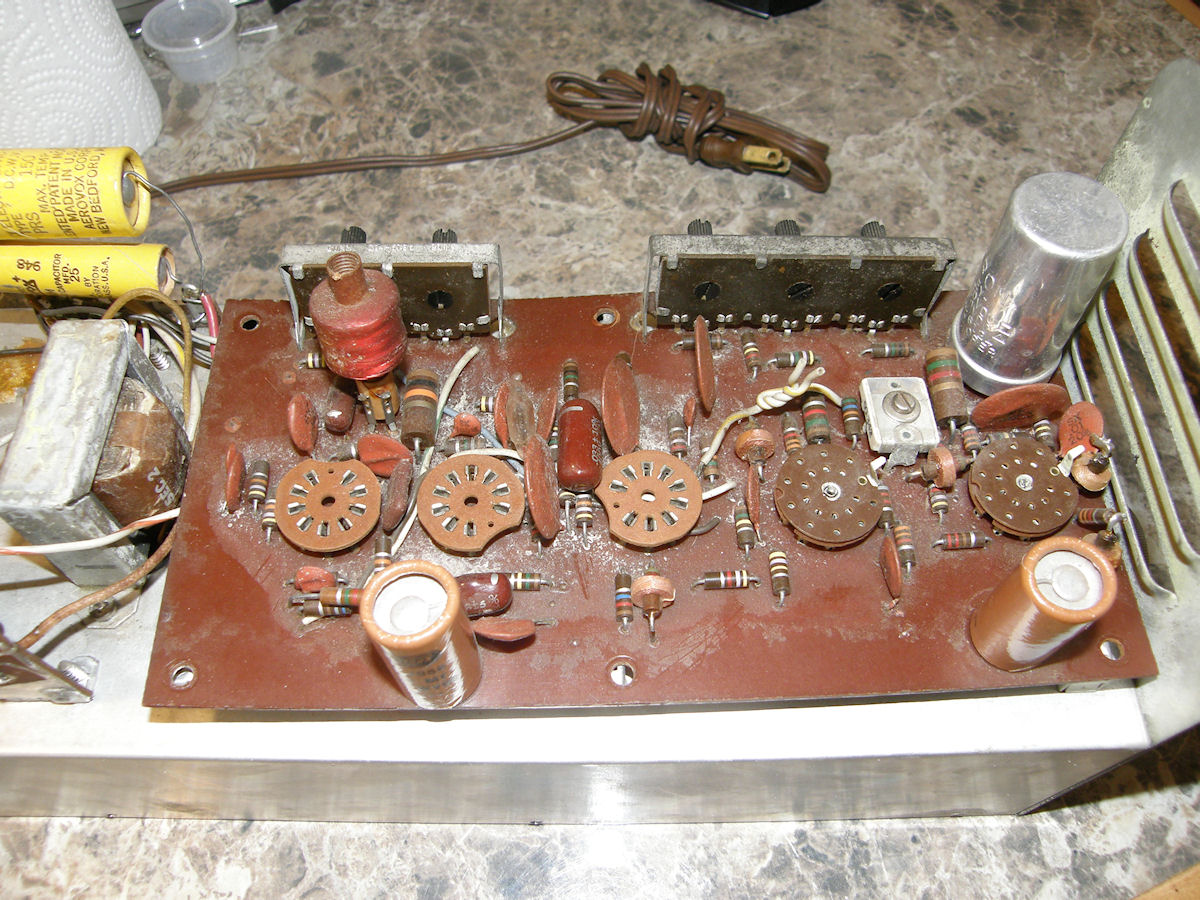
Power supply reinstalled and rewired, next stop the video board - 20161001 The numbered tags on the wires made it very easy to reinstall them. The boards looks much better with all the old crud scrubbed off as well. The modern capacitors are much lower mass than the original parts, removing a lot of the mechanical load that was on the PCB. During the rewiring, one wire was too short and was replaced. That is the green wire that takes B+ to the rear panel for one or more of the controls. In the second photo, you can see the video board after I cleaned it with an electronics spray cleaner. Though all the dust is gone, a waxy substance still coats the surface of the PCB. I may end up pulling this board out and cleaning it with soap and warm water using a soft brush to get into the crevices. But, there are many more wires attached, beneath this board, than on the power board. It is somewhat intimidating. The very next step is to replace the large silver capacitor, seen in the upper right of the last photo, and the two upright tubular capacitors seen along the bottom edge of the board. At that point, it will be possible to power up the chassis without tubes and take power supply and DC leakage measurtements. I have already checked the DC resistance between the terminals of the AC power connector. No measurable leakage to the chassis detected from the AC plug's pins in either the on or off mode. Infinite resistance measured between the terminals in the power off mode and about 11 ohms DC resistance in the power on mode. These are all acceptable results. I see the designer chose to leave out a safety fuse. I may very well install one shortly... no pun inteneded! 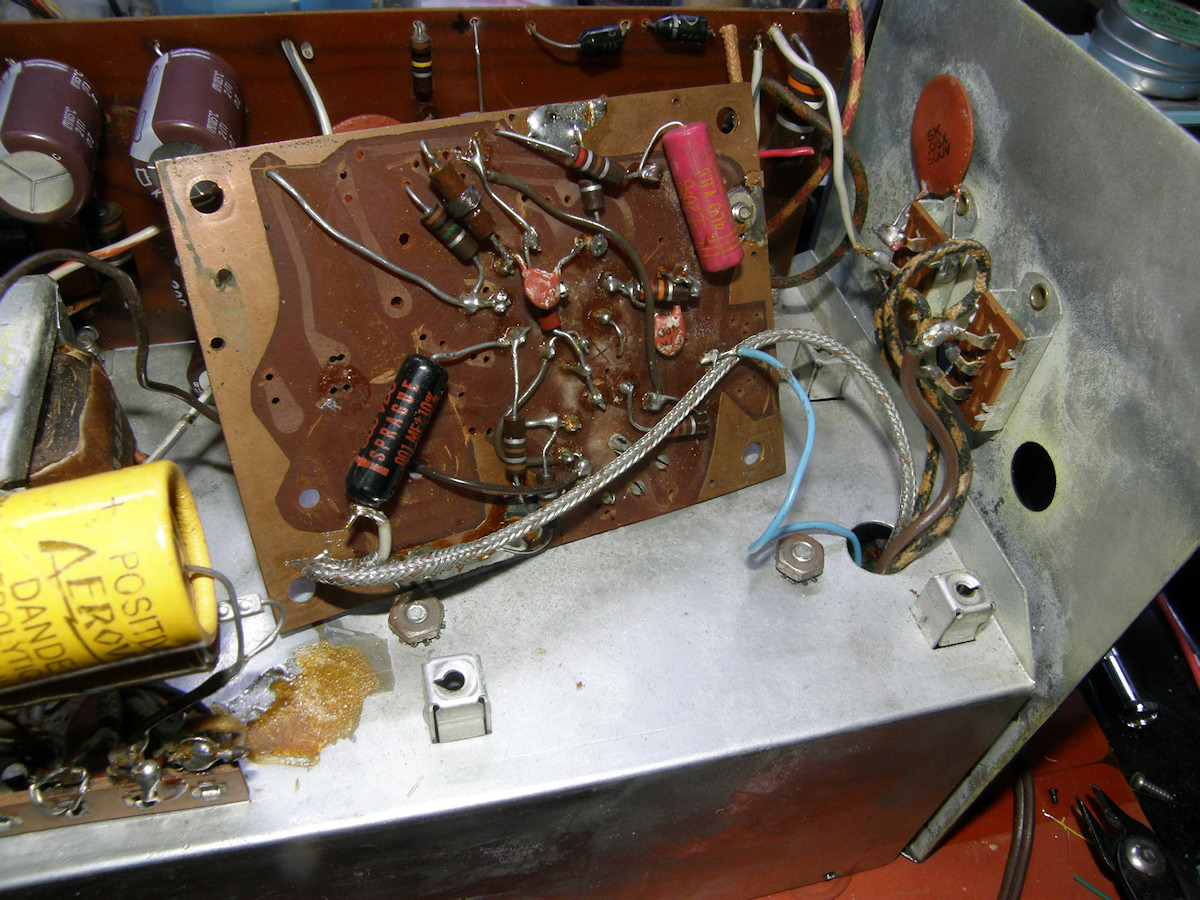
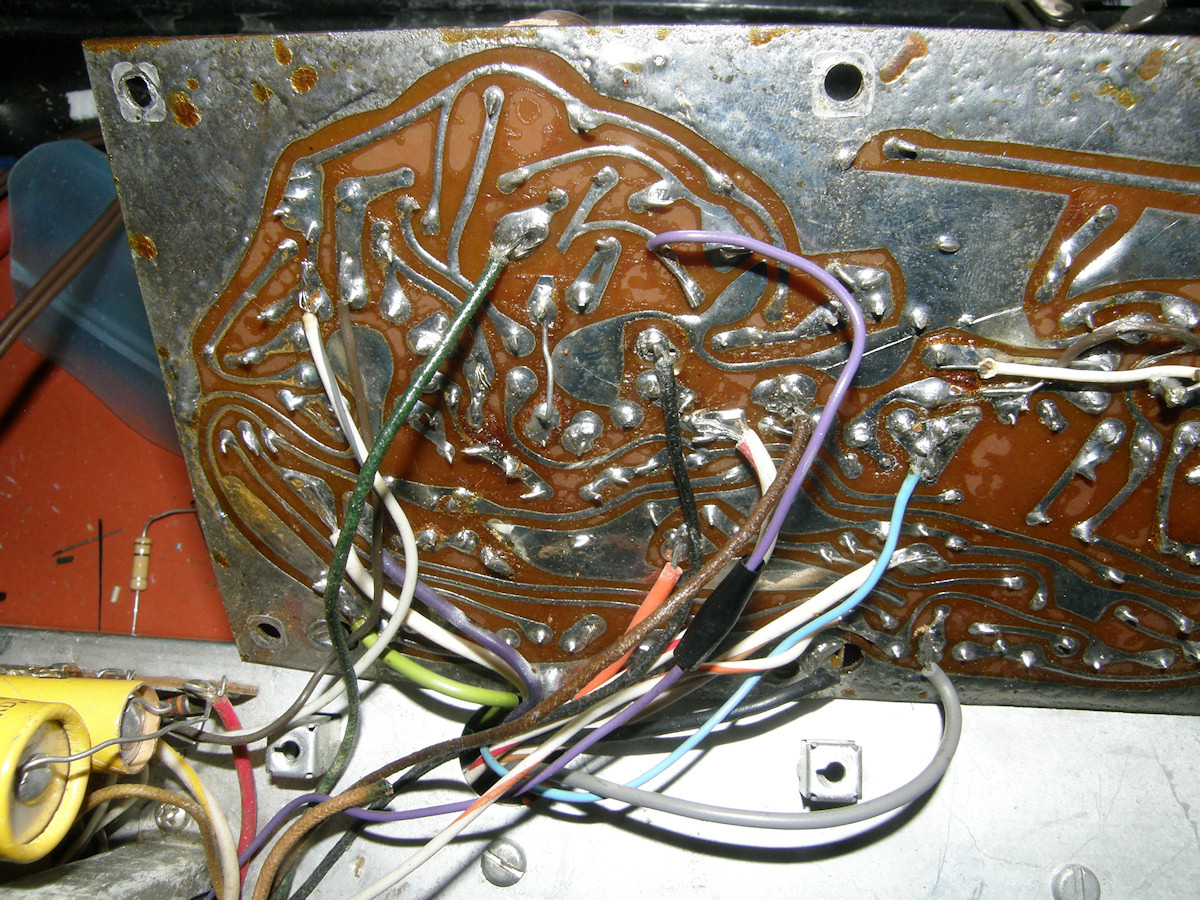
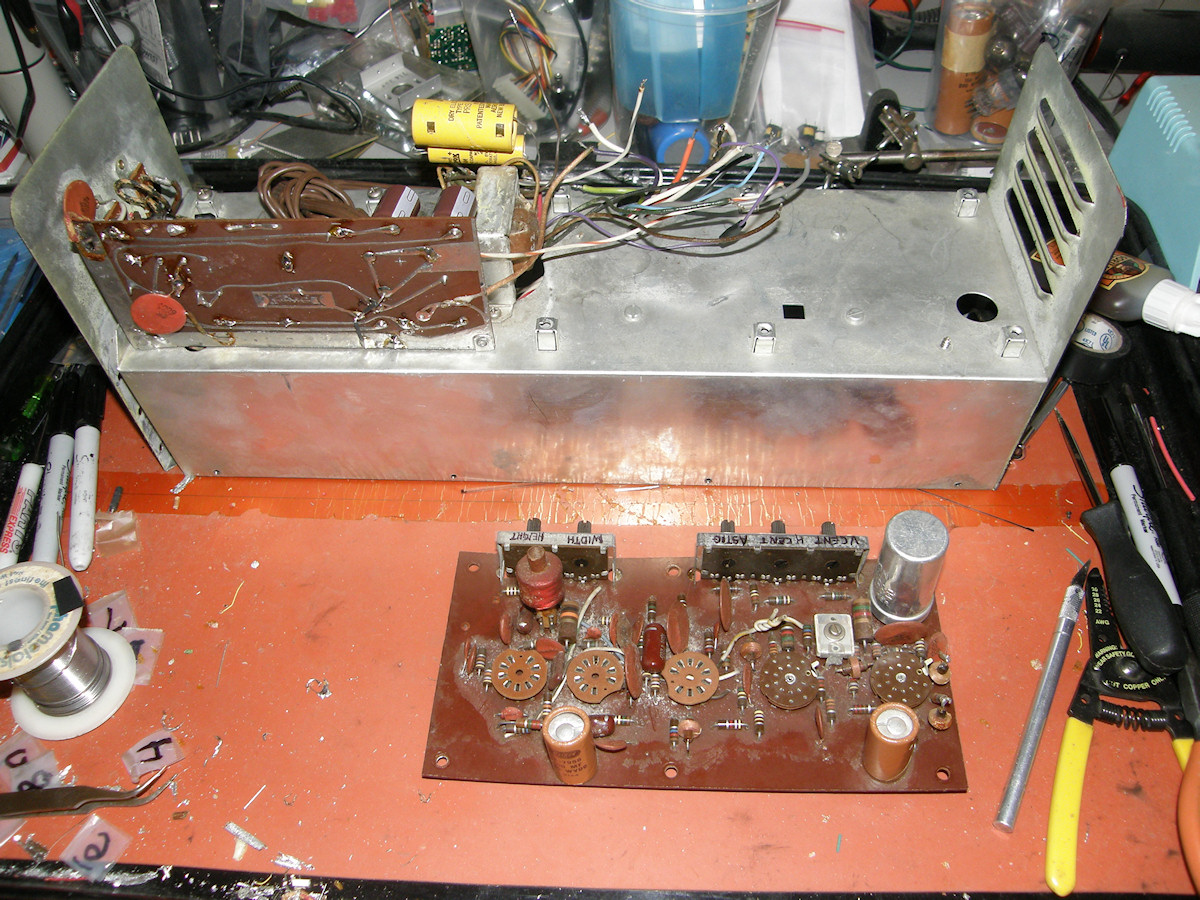
Removing the RF modulator board and the video board - 20161002 As I considered the options for restoring the video PCB properly, I became aware that it was going to have to come out of the chassis altogether. Since I don't want the high powered RF converter board broadcasting all over the neighborhood, it was removed as well, first photo. Next, I took at least fifty photos of the wires on the bottom of the video board from every possible angle for future reference. The second photo, above, shows the rat's nest of wires that connected to the unlabeled PCB traces. In the last photo, you can see the video board is free and all the wires sticking up from the chassis. I already dread the day I get to reconnect them all! Note also, that I labeled the potentiometers by function. 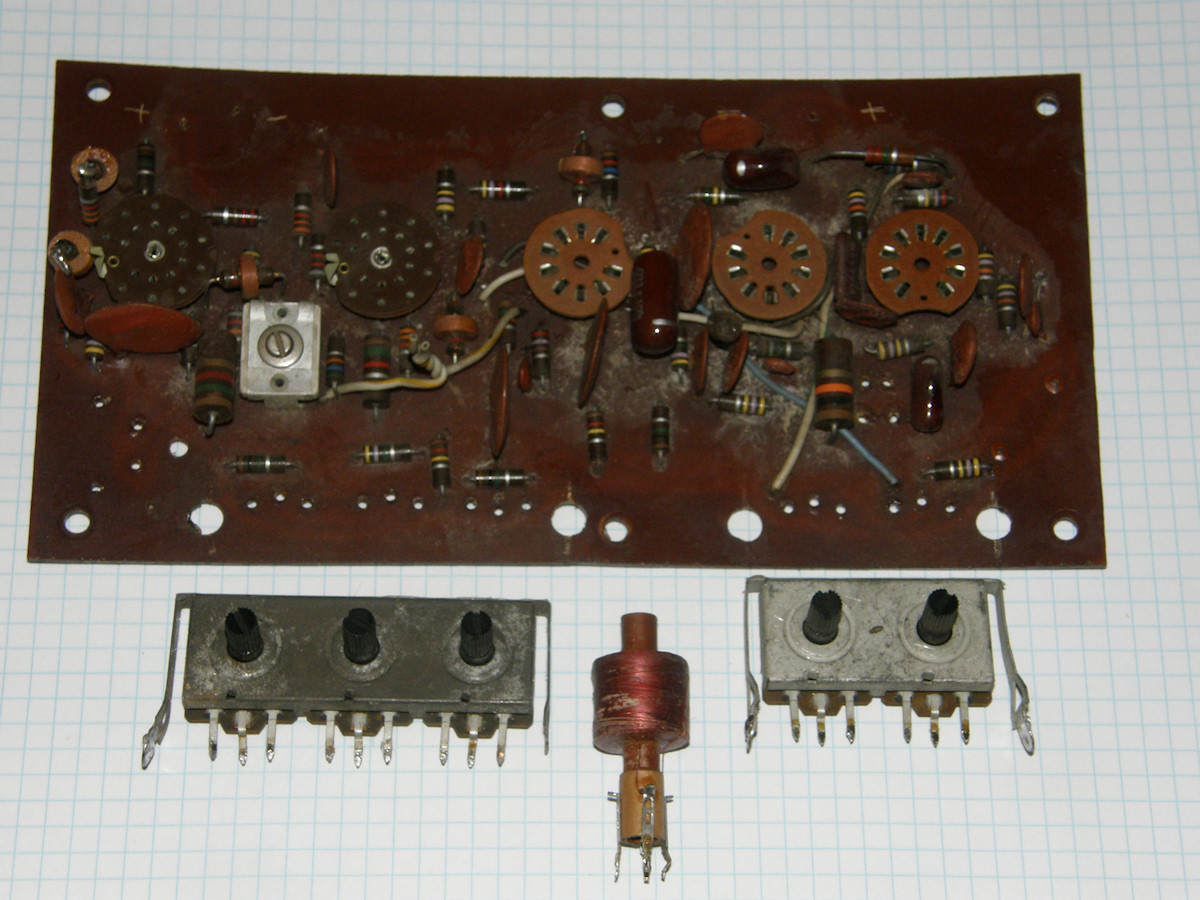
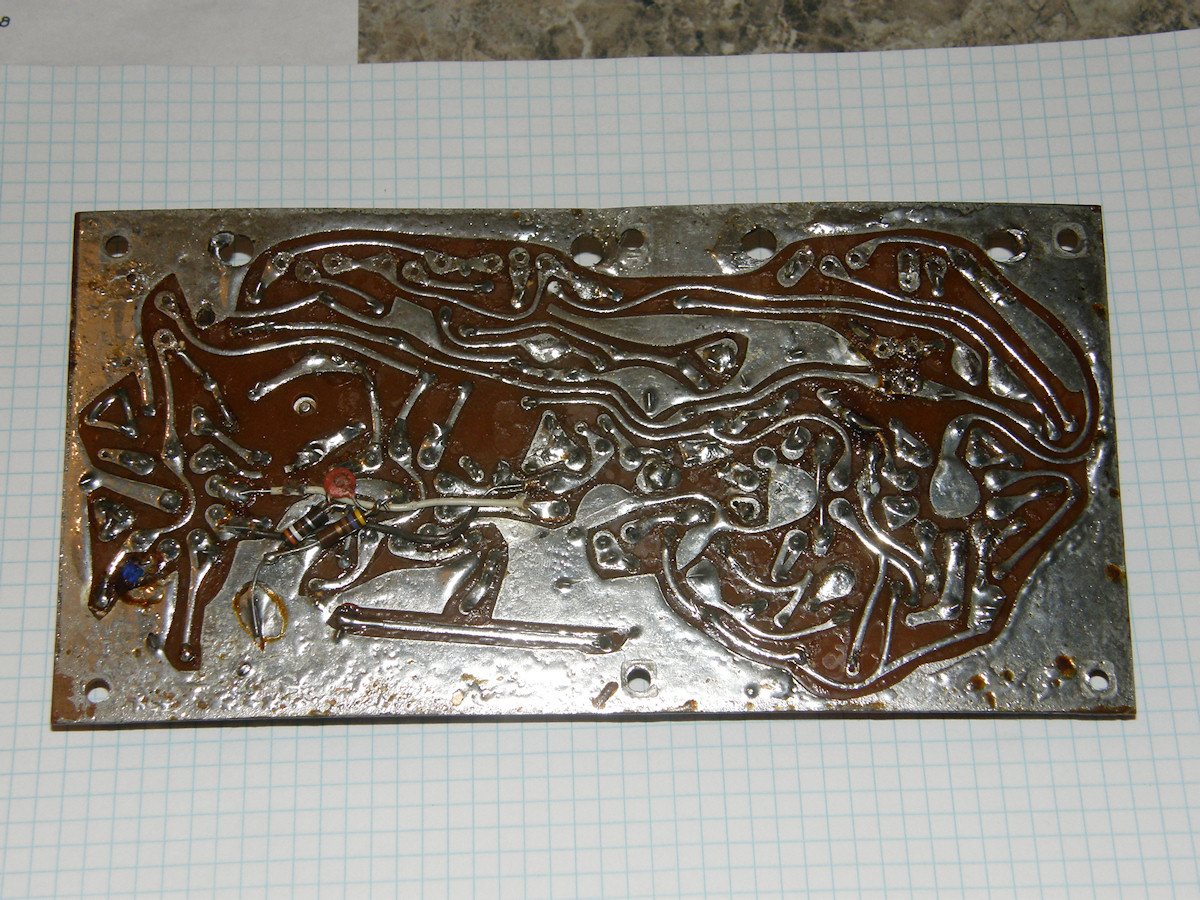
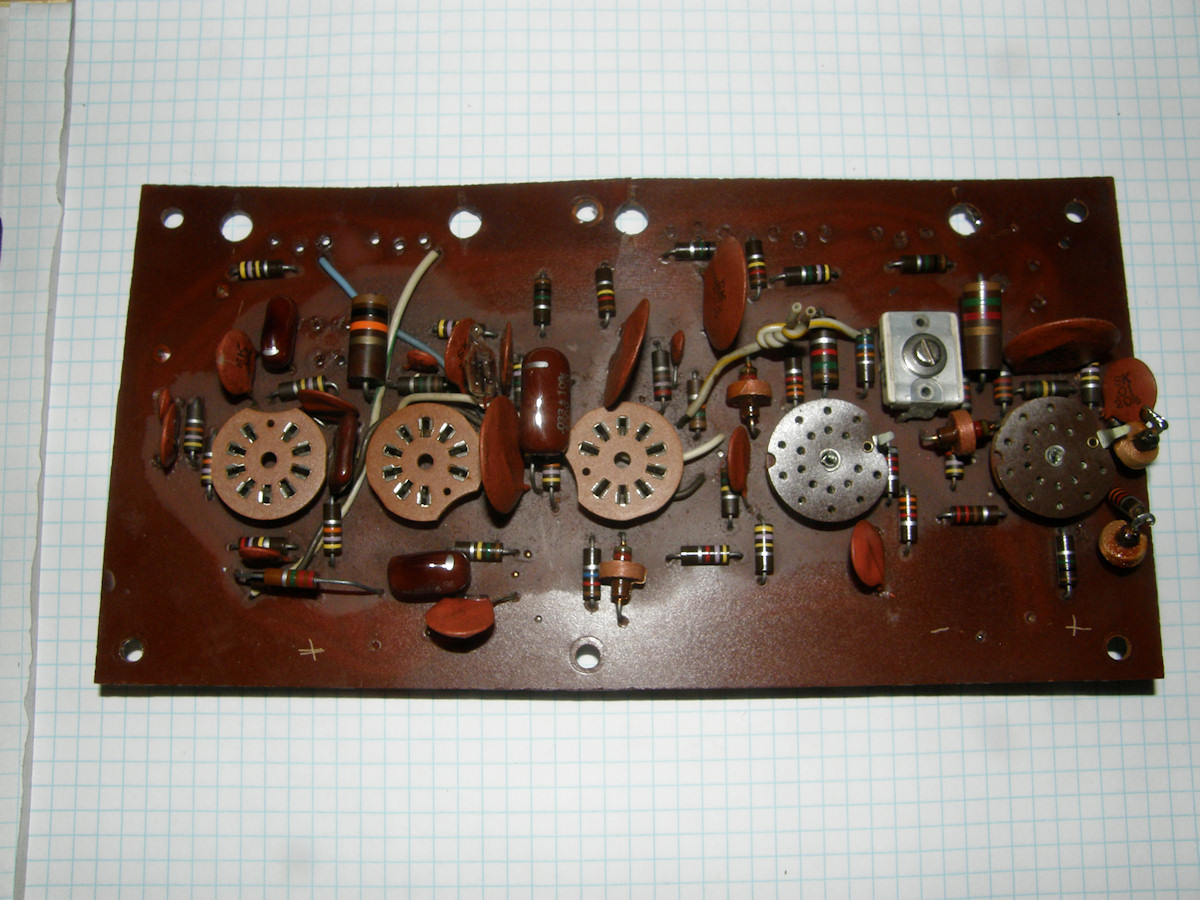
Removing the the fragile components and cleaning the board - 20161002 The ganged poteniometers probably should not get wet. The horizontal oscillator ringing coil is easily snapped off. So they must come off to prevent unnecessary damage. Note also that the large silver canned dual electrolytic and two other electrolytic capacitors have been removed. New capacitors are ready to install. Photos two and three show the board after I washed it with dish soap and a soft paint brush in the kitchen sink. The results are not perfect. But they are acceptable now. The old phenolic board is seriously warped and showing its age. After washing, I carefully dried front and back with my little 1200 watt hot air gun. Then hung the board in front of my room fan to air dry further. The soap and water did no apparent damage. 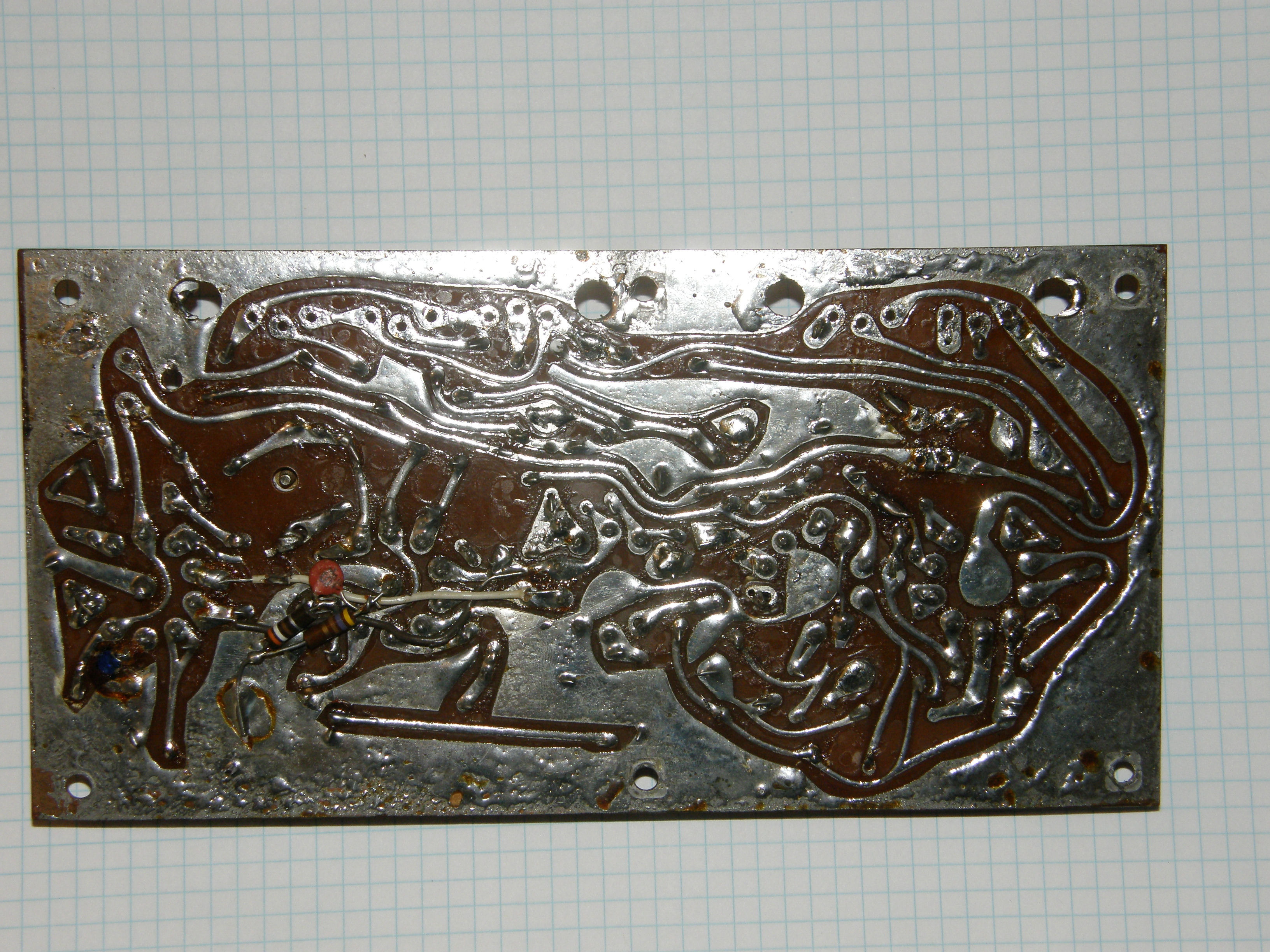
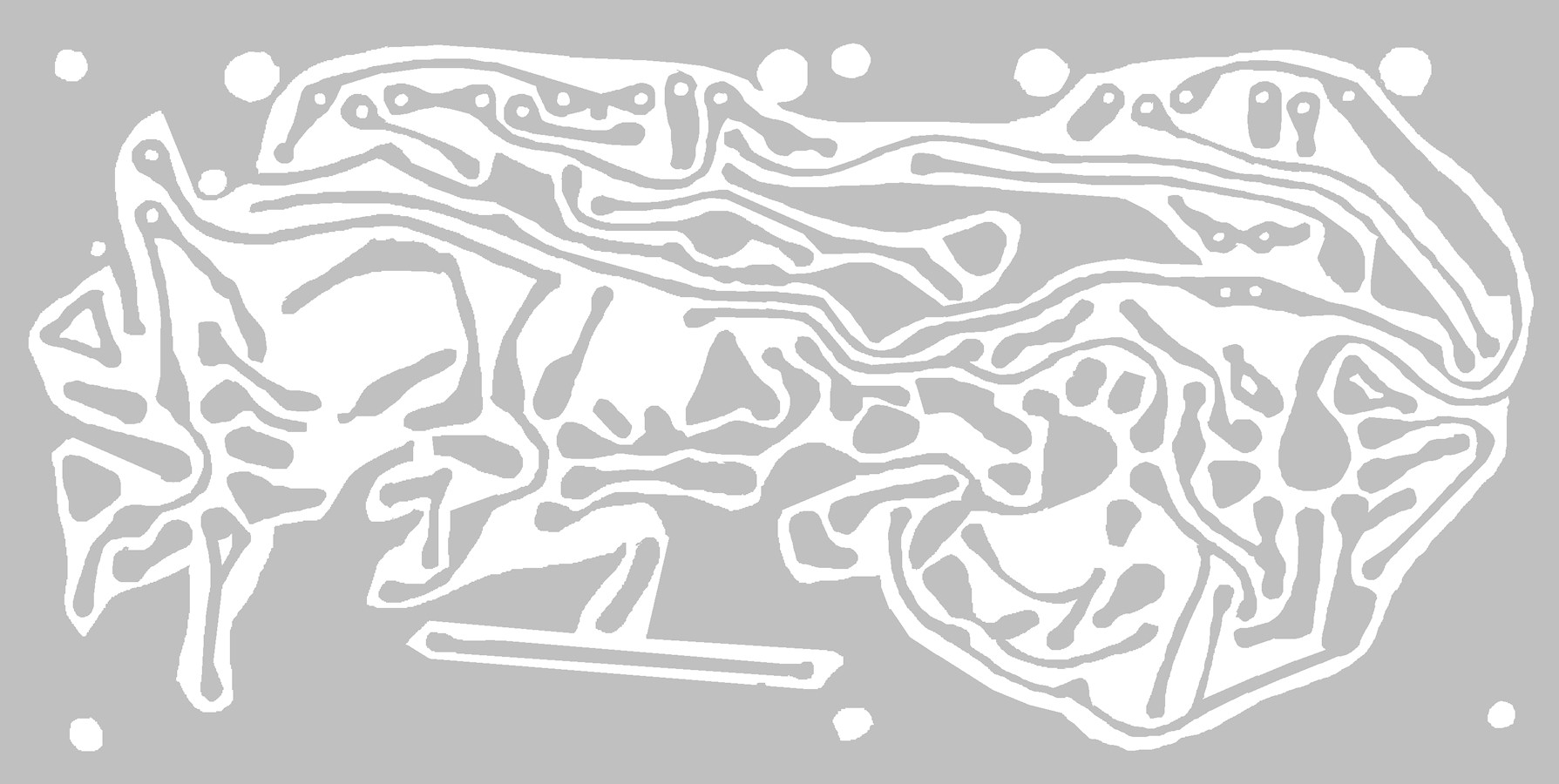
Generating usable documentation - 20161002 I am going to need final documentation to complete this project. So, using my Paint Shop Pro, I quickly traced out just the paths of the copper traces. More details will be added as I go. A mirror imaged copy of this one represents the top side or X-ray view of the board. Several printed copies of each side will allow me to write on them with colored pens or pencils. Once the notes are final, they will be scanned and posted back to this article. 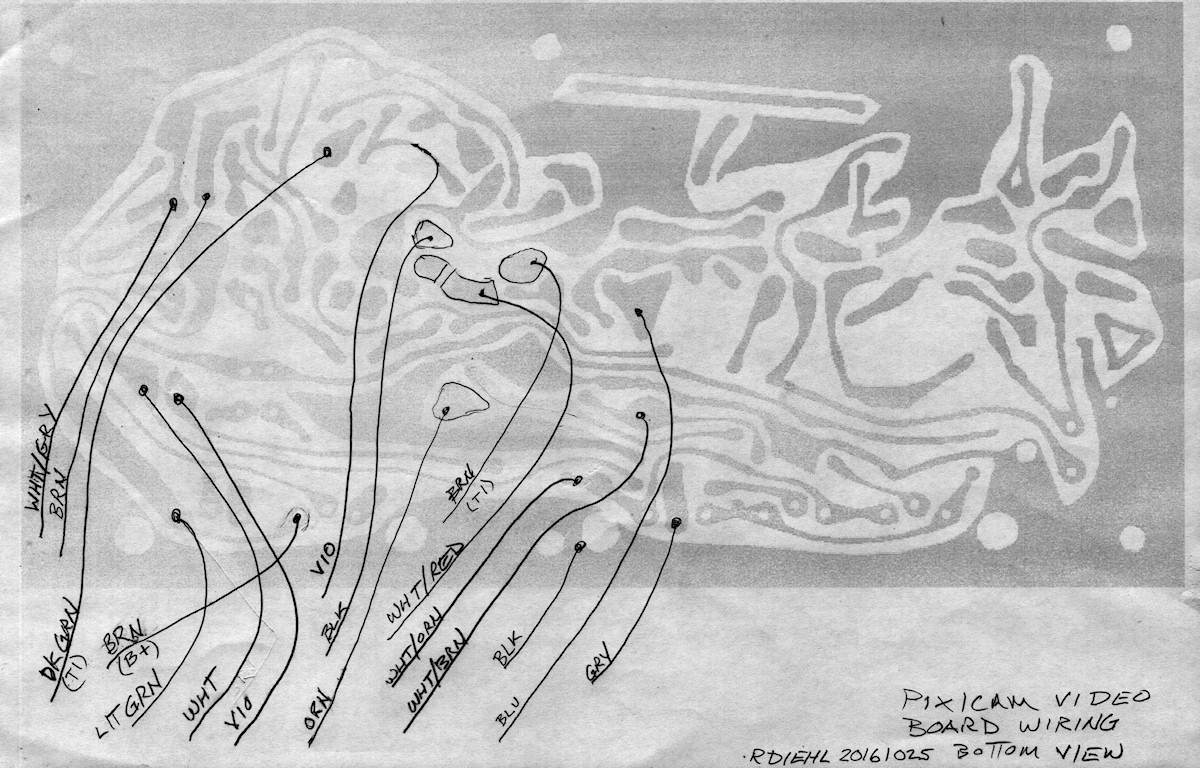
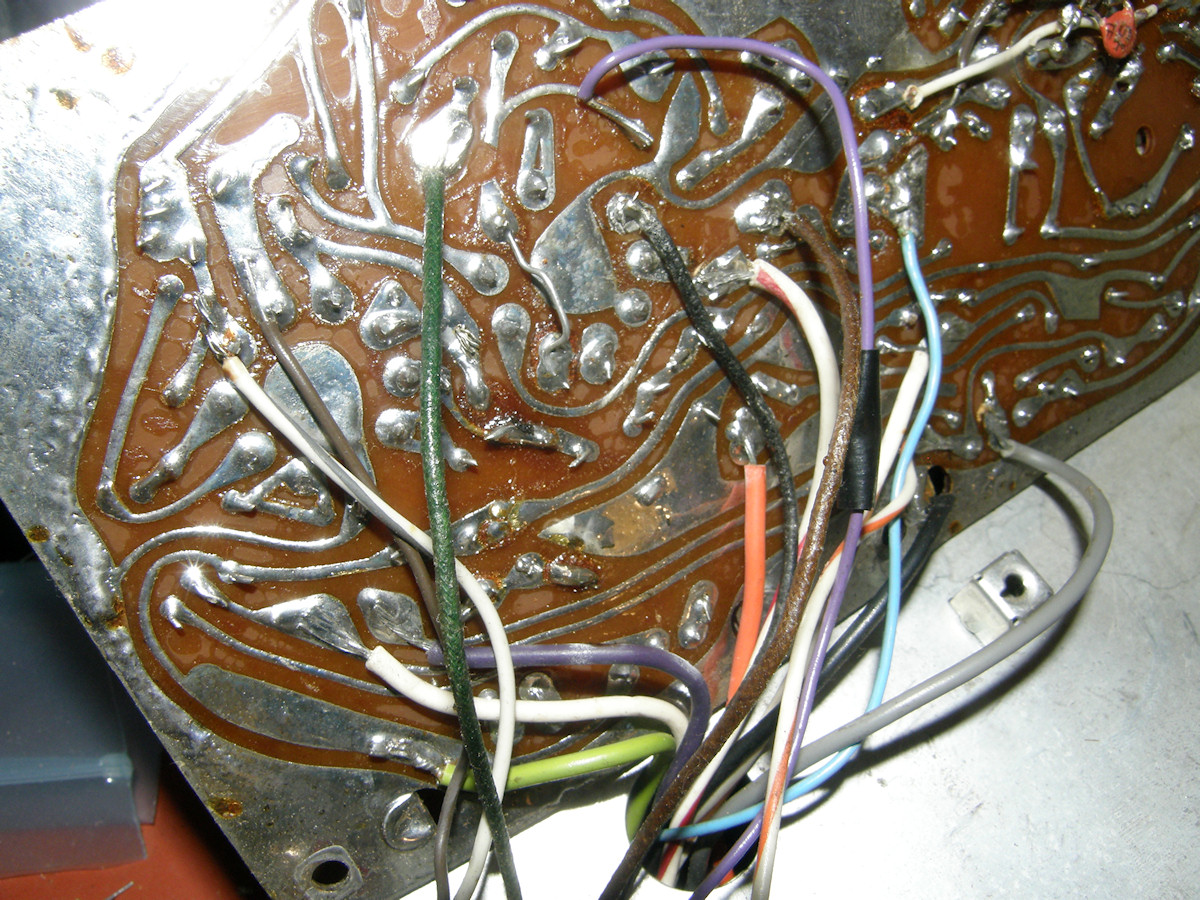
Video board wiring connections - 20161025 My circuit board work sheet proved very handy today. I was able to reconnect all 16 of the wires in an hour or so. Taking a couple of dozen photos of the wiring harness and PCB assisted in creating this wiring diagram. As a result, reinstalling the video board went smoothly and swiftly. Video of the board wiring connections - 20161025 Rather than bore you with paragraphs of stumbling prose describing this operation, I have made a boring video instead! Hard core old school electronics restoration for true enthusiasts. Enjoy! Video of the first turn on voltage measurements - 20161026 Another day, another video. Got around to checking the voltages and more. Enjoy the next video. Video of the final assembly and first light - 20161027 We put the pixicon tube in the camera and fire it up. I show you how to make a handy dandy test pattern for your camera bench. We learn of the risks of reviving antique electronics. Video of my Pixicam project conclusions - 20161028 I summarize what I have learned and wrap up this project for good. The Pixicon tube is 56 years and one week old at the conclusion of this article. I turned 59 this week myself. How cool is that? Let's take a moment to remember Al Denson, propriator of Denson Electronics, an electronics surplus store that specialized in television equipment. Denson Electronics flourished during the 1960s and 1970s. I purchased much my first TV camera parts from Al Denson. Without Denson acquiring the assets from Marsan Industries, these cameras could have all gone to the land fill in one catastrophic act. But Denson sold them for years. As a kid, I dreamed of getting a Pixicam of my own. It took a few years. But, the dream is realized. What an excellent piece of late 1950s engineering. RIP Al Denson. This is a completed project. REFERENCES: 1. PDF file [The Pixicam flyer from Denson Electronics ] from around 1970. I have had the schematics of this camera for years! Enjoy. 2. PDF file [Advertising flyer from Denson Electronics ] from around 1970. Denson Electronics had the coolest surplus video equipment on Earth! God bless Al Denson. RIP, brother. 3. PDF file [Data sheet for vacuum tube 6C9 ] VHF Duo Tetrode 4. PDF file [Data sheet for vacuum tube 6EA8 ] Medium-Mu Triode - Sharp-Cutoff Pentode 5. PDF file [Data sheet for vacuum tube 6EZ8 ] Triple Triode [HOME] [ELECTRONICS PROJECTS] [PART 1] Created: August 20, 2016 Last updated: October 28, 2016 |